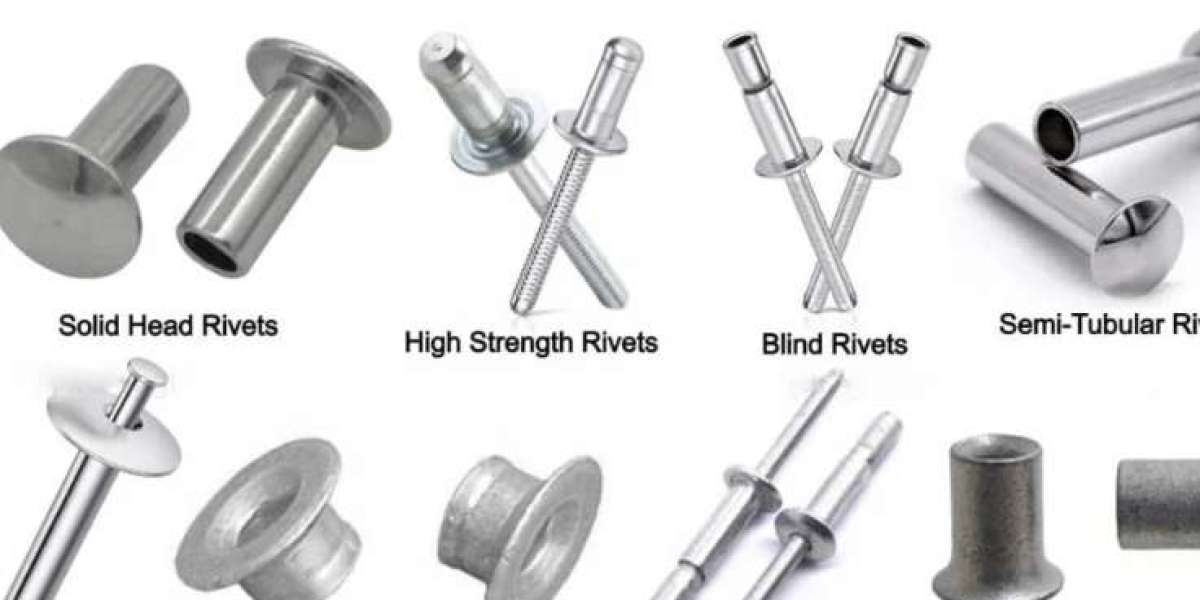Introduction to Rivets
Rivets are one of the oldest fastening methods in the world of construction and manufacturing. Their ability to securely join two or more materials together has made them indispensable across various industries, including aerospace, automotive, construction, and more. The different types of rivets available today offer flexibility in design and function, with each type serving a specific purpose. Understanding these different types, their uses, and how they work is essential for selecting the right rivet for your project. This article will explore the various types of rivets, their characteristics, and where they are commonly used.
What are Rivets?
A rivet is a mechanical fastener used to permanently join two or more materials together. Typically, rivets consist of a cylindrical shaft with a head on one end. The shaft is inserted into pre-drilled holes in the materials being joined, and the opposite end is then deformed, creating a second head that holds the materials tightly together.
Rivets are used in situations where welding or screws are not feasible, especially when the materials involved are difficult to join. The simplicity and durability of rivets make them ideal for high-stress applications, offering long-term strength and reliability.
Key Types of Rivets
There are several types of rivets, each designed for specific applications based on their features and installation requirements. The most commonly used rivets include solid rivets, blind rivets, semi-tubular rivets, and drive rivets. Let’s look at each type in detail.
1. Solid Rivets
Solid rivets are one of the most common and traditional types of rivets. They are typically used in heavy-duty applications where high-strength fastening is needed. The rivet consists of a solid shaft and a head, and it requires special tools for installation, such as a rivet hammer or pneumatic riveter.
- Installation: The rivet is inserted into a pre-drilled hole, and the tail is deformed using a tool, creating a second head to hold the materials in place.
- Applications: Solid rivets are commonly used in structural applications like bridges, aircraft manufacturing, and railcars. Their robust design makes them suitable for high-stress environments.
Advantages:
- Provides maximum strength and durability
- Permanent and highly secure fastening
- Excellent resistance to vibration
Disadvantages:
- Requires access to both sides of the material
- Installation is labor-intensive and requires specialized tools
2. Blind Rivets
Blind rivets, also known as pop rivets, are designed for applications where access to only one side of the workpiece is available. These rivets have a unique feature: the mandrel (or stem) is pulled through the rivet body to create the second head. This deformation creates a secure connection, and the mandrel is broken off, leaving a permanent bond.
- Installation: Blind rivets are installed by inserting the rivet into a hole and pulling the mandrel with a special tool, which deforms the rivet body to secure the materials together.
- Applications: These rivets are commonly used in sheet metal, automotive, and construction applications, where access to the back of the materials is not possible.
Advantages:
- Can be installed from one side only
- Quick and easy installation
- Ideal for thin or delicate materials
Disadvantages:
- Lower strength compared to solid rivets
- Not suitable for applications requiring heavy-duty fastening
3. Semi-Tubular Rivets
Semi-tubular rivets are similar to solid rivets but have a hollow shaft on one end. This design allows the rivet to be set with less force compared to solid rivets, making installation easier and faster. The hollow end of the rivet also reduces the weight, which can be beneficial in certain applications.
- Installation: Semi-tubular rivets are installed by inserting the rivet into a hole and then applying pressure to deform the shaft, creating a second head on the opposite side. The hollow end of the rivet is compressed during the installation.
- Applications: These rivets are commonly used in applications that require a combination of strength and lighter weight, such as in electronics, automotive, and furniture manufacturing.
Advantages:
- Faster and easier to install than solid rivets
- Lighter and more cost-effective
- Provides a good balance of strength and flexibility
Disadvantages:
- Not as strong as solid rivets
- Can’t be used in extremely high-stress environments
4. Drive Rivets
Drive rivets, also known as drive-in rivets, are a type of blind rivet designed for easy installation. These rivets do not require any special tools; instead, they are set by hammering the rivet into place. The driving action deforms the rivet’s shaft, securing the materials together.
- Installation: Drive rivets are installed by driving the rivet’s shaft into a hole using a hammer or specialized tool. The rivet body is compressed to create a secure connection.
- Applications: These rivets are typically used in light-duty applications such as automotive trim, appliance assembly, and general construction.
Advantages:
- Fast and easy to install
- No special tools required
- Ideal for light-duty applications
Disadvantages:
- Not suitable for heavy-duty or structural applications
- Lower holding strength compared to other rivet types
5. Explosive Rivets
Explosive rivets, a specialized type of rivet, are primarily used in applications where vibration resistance and high-strength connections are essential. These rivets use a controlled explosion to create the deformation needed to set the rivet, providing a strong and secure bond.
- Installation: Explosive rivets are installed by triggering a small explosion that deforms the rivet body. This process is quick and efficient.
- Applications: Explosive rivets are often used in aerospace, defense, and heavy machinery applications where vibration resistance is critical.
Advantages:
- Extremely strong and secure
- Ideal for high-vibration or high-stress environments
Disadvantages:
- Requires specialized equipment and training
- Expensive compared to other rivet types
6. Socket Rivets
Socket rivets are commonly used in applications where both strength and ease of installation are required. These rivets feature a cylindrical body with a recessed socket, which allows for easy insertion and deformation.
- Installation: The rivet is inserted into a pre-drilled hole, and the socket is deformed using a hammer or other tools to secure the materials.
- Applications: Socket rivets are used in various mechanical and construction applications where strong, permanent fastening is required.
Advantages:
- Easy to install
- Strong and reliable fastening
Disadvantages:
- Requires access to both sides of the workpiece for installation
Factors to Consider When Choosing Rivets
When selecting a rivet type, several factors must be considered to ensure the correct choice for your application. These factors include:
- Material Compatibility: Ensure that the rivet material is compatible with the materials being joined, such as aluminum, steel, or plastic.
- Strength Requirements: Some applications require stronger rivets for added security, while others may only need lighter rivets for non-structural tasks.
- Access to Both Sides: If access to both sides of the workpiece is limited, a blind rivet or drive rivet might be the best choice.
- Vibration Resistance: In applications subject to vibrations, such as in aerospace or automotive industries, selecting rivets that offer high vibration resistance is essential.
Conclusion
Rivets play a critical role in fastening materials in various industries. From solid rivets used in heavy-duty applications to blind rivets perfect for situations with limited access, each type has its advantages and ideal uses. Understanding the characteristics of each rivet type will help you make informed decisions about which one to use for your project. Whether you need strength, ease of installation, or vibration resistance, there is a rivet type suited for every application. By selecting the correct rivet, you ensure that your fastening solution will meet your design and durability requirements.





